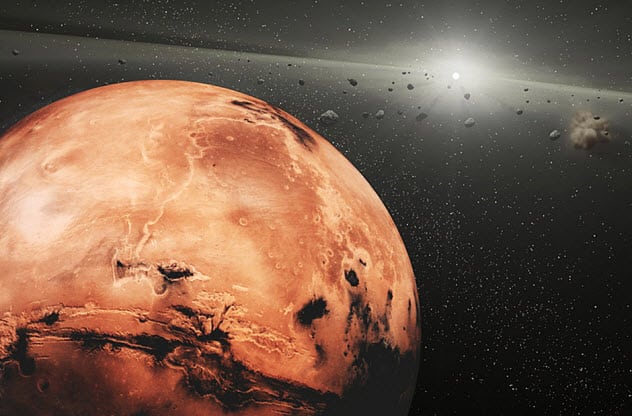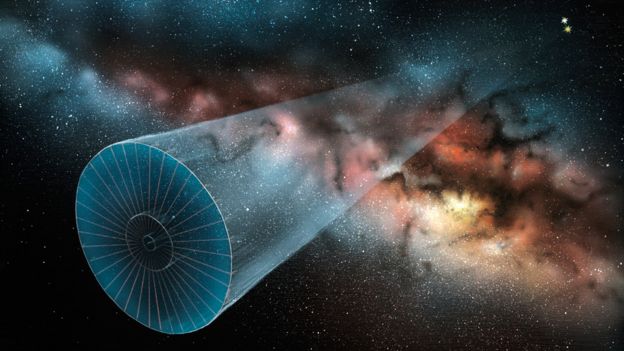
There are many different types of objects found in the solar system: a star, planets, moons, dwarf planets, comets, asteroids, gas, and dust. In terms of the numbers of each of these objects, our current knowledge is as follows:
- 1 star (The Sun)
- 8 planets (Mercury, Venus, Earth, Mars, Jupiter, Saturn, Uranus, and Neptune)
- 5 dwarf planets (Pluto, Ceres, Haumea, Makemake, and Eris)
- 181 moons
- 566,000 asteroids
- 3,100 comets
7. Martian Day Is Barely Longer Than An Earth Day

Photo credit: universetoday.com
A day is determined by how long it takes a planet to revolve on its axis. Planets that take longer to complete a revolution
have longer days than those with faster revolutions. The length of a
day varies greatly on each planet because they all take different times
to complete a revolution.On Earth, a day is 24 hours long. On Jupiter, it is 9 hours, 55 minutes, and 29.69 seconds long. On Venus, it is 116 days and 18 hours long. On Mars, it is 24 hours and 40 minutes long. Given the disparity between the lengths of a day on every planet, how did Earth and Mars end up with days of similar length?
Pure coincidence.
Planets are created when dust clouds released during the formation of stars lose momentum while spinning (revolving). The spin increases or decreases as the planet hits other objects in its neighborhood. They do hit a lot of things, so the rate of the spin changes a lot.
The planet soon clears and dominates its neighborhood. At this moment, it no longer collides with anything and maintains the spin it had the last time it hit something.
6. You Could Fit All the Planets Between the Earth and the Moon

The average distance from the Earth to the Moon is 384,400 km. And check it out, that leaves us with 4,392 km to spare.
So what could we do with the rest of that distance? Well, we could obviously fit Pluto into that slot. It’s around 2,300 km across. Which leaves us about 2,092 km to play with. We could fit one more dwarf planet in there (not Eris though, too big).
The amazing Wolfram-Alpha can make this calculation for you automatically: total diameter of the planets. Although, this includes the diameter of Earth too.
| Planet | Average Diameter (km) |
| Mercury | 4,879 |
| Venus | 12,104 |
| Mars | 6,771 |
| Jupiter | 139,822 |
| Saturn | 116,464 |
| Uranus | 50,724 |
| Neptune | 49,244 |
| Total | 380,008 |
5. But the Solar System is bigger than you think.

Beyond the orbit of Neptune (the furthermost planet), it takes a long time to leave the Solar System. In 2012, some 35 years after leaving Earth on a one-way trip to the outer solar Solar System, Voyager 1 passed through the area where the Sun’s magnetic and gas environment gives way to that of the stars, meaning that it is interstellar space. That was an astounding 11 billion miles (17 billion kilometers) away from Earth, or roughly 118 equivalent Earth-sun distances (astronomical units)
The key outcome is that the solar system is bigger than previous findings suggested. This is based around the furthest object that takes an orbit around the Sun, based on the Sun’s gravitational pull. This edge of the solar system is well past Pluto and even beyond the Kuiper Belt (a circumstellar disc in the Solar System beyond the planets, composed of frozen volatiles and dwarf planets).
New data suggests there are objects orbiting around our Sun at up to 200 times further away than the Earth. This means the beginning of interstellar space is much further out. This comes as astronomers are recording more and more strange objects in the outer reaches.
4. Mars Has Frozen Water Today:

We’re very interested in the question of water because it implies habitability; simply put, life as we know it is more likely to exist with water there. In fact, the Curiosity rover’s mandate on Mars right now is to search for habitable environments (in the past or present). Mars has a thin atmosphere that does not allow water to flow or remain in large quantities on the surface, but we know for sure that there is ice at the poles — and possibly frosty locations elsewhere on the planet. The question is if the ice is capable of melting enough water in the summer long enough to support any microbes.
Water is thought to have flowed across the surface of Mars billions of years ago, when its atmosphere was thicker and warmer, cutting gullies and channels that are still visible. But today, low atmospheric pressures mean that any surface water would boil away. Water survives frozen in polar ice caps and in subsurface ice deposits.
3. Nearest Star To Earth is Proxima Centauri

Outside of our own solar system, the nearest star to Earth is a red dwarf star called Proxima Centauri (4.24 light-years), followed by Barnard’s Star in the constellation of Ophiuchus (6 light-years). The brightest star in the night sky, Sirius (-1.46 magnitude) in the constellation of Canis Major, is the 5th closest star to Earth at a distance of 8.6 light years.
2.Europa

Photo credit: NASA/Jet Propulsion Lab-Caltech/SETI Institute
Europa is one of Jupiter’s moons
here in our own solar system. It is another candidate due to its
potential to hold liquid water. Europa is thought to have all the
necessities for life including water, energy sources, and the right
chemical buildup. The water is thought to be stored in oceans underneath
Europa’s surface.It wasn’t until recently that scientists made it possible to begin the exploration for life on this moon. It was announced in early 2017 that a mission called Europa Clipper would take place over the next several years. This mission is sending a spacecraft to Jupiter’s moon to take pictures of the surface. This flyby would happen repeatedly, offering multiple opportunities to analyze the moon and search for life.
1. We live inside the sun.

Normally we think of the sun as being that big, hot ball of light 93 million miles (150 million km) away. But actually, the sun’s outer atmosphere extends far beyond its visible surface. Our planet orbits within this tenuous atmosphere, and we see evidence of this when gusts of the solar wind generate the Northern and Southern Lights. In that sense, we definitely live inside the sun. But the solar atmosphere doesn’t end at Earth. Auroras have been observed on Jupiter, Saturn, Uranus, and even distant Neptune. In fact, the outer solar atmosphere, called the heliosphere, is thought to extend at least 100 A.U. That’s nearly 10 billion miles (16 billion km). In fact the atmosphere is likely teardrop shaped due to the sun’s motion in space, with the “tail” extending tens to hundreds of billions of miles downwind.

Informative article. Thanks for sharing such an valuable article. Also visit my website for Microsoft Office Setup Help Number. Microsoft Office Setup Help Number